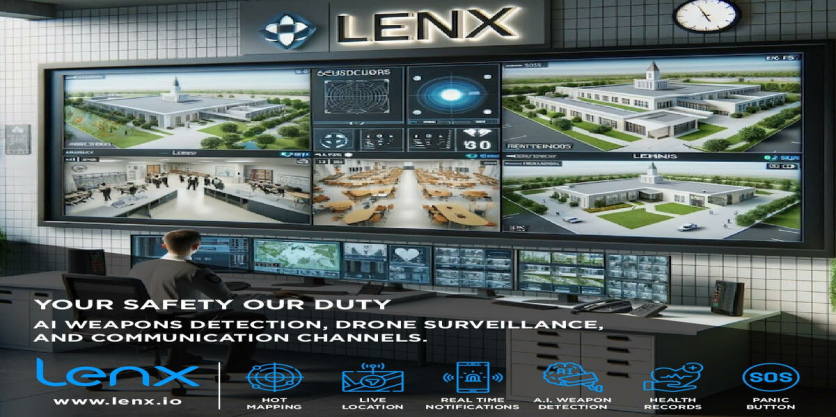
In Washington, DC, more than 35,000 surveillance cameras are being used as part of the city's public safety infrastructure. In Chicago, there are more than 48,000 cameras, and in Atlanta, there are more than 60,000.
Surveillance cameras monitor public spaces in virtually every large city in the US. However, experts say that watching alone can't provide adequate safety in today's ever-evolving threat landscape.
"The majority of surveillance cameras used in the US public safety infrastructure are not doing enough," explains Hussein AbuHassan, President and Founder of LENX. "They see activity, but they don't interpret it. Even where systems have been enhanced to detect objects without human assistance, those enhancements rarely provide the context needed to reliably optimize public safety."
LENX is at the forefront of revolutionizing public safety by leveraging the power of advanced AI security systems. It specializes in weapons detection, drone surveillance, and communications solutions with a platform that combines state-of-the-art threat detection with an innovative mobile application that connects users directly with law enforcement and other security professionals.
"The US is not lacking surveillance cameras—there are 11 cameras for every 1,000 people in the average US city, regardless of size," AbuHassan shares. "While these cameras are available, they are not efficient or effective enough to address the rise in violence in public spaces. The systems currently in place can't provide the fast, accurate, intelligent responses needed when a public safety crisis occurs, and lives are at risk."
The Shortcomings of Today's Surveillance Infrastructure
A recent report on public safety surveillance in San Francisco unveils one of the chief shortcomings of today's infrastructure, stating that cameras managed by police are in place, but not continuously monitored, meaning they aren't detecting developing threats. The images they capture are being used as evidence when crimes go on trial, but they aren't being used to stop crimes before they happen.
"The current public safety surveillance infrastructure in the US is due for an overhaul," AbuHassan says. "Its shortcomings include limited scalability, over-reliance on human operators for monitoring, high frequency of false alarms, and an inherent inability to effectively analyze large volumes of data in real-time."
The Power AI Brings to Surveillance Efforts
Artificial intelligence excels at object recognition, and its capability for massive data processing allows it to categorize endless examples of images, recognizing patterns and subtle variations.
"AI can dissect images, extracting the shapes, colors, textures, and other key features that define objects to obtain the information it needs to differentiate objects," AbuHassan explains. "Integrating AI into public safety systems allows its object recognition capabilities to be leveraged for threat recognition. Once it has been trained to identify weapons and other threats, it can detect them even in cluttered or rapidly changing environments."
AI also brings the power of rapid statistical analysis to surveillance activities by combining statistical probabilities with visual data to improve the accuracy of object recognition. Statistical analysis has the potential to bring the context to surveillance that today's systems are lacking.
"AI integrations can significantly improve the accuracy and efficiency of surveillance systems," says AbuHassan. "It can greatly enhance surveillance by providing advanced video analytics capabilities such as behavior analysis and anomaly detection. It also empowers real-time detection and notification, which enables quicker response times. AI-aided threat detection is next-level threat detection."
The LENX platform is trained on vast datasets to recognize the unique signatures of weapons. Objects that pose a threat to public safety, such as guns and knives, are detected by AI based on features that include shape, size, and material composition. Millimeter-wave imaging, thermal imaging, and other advanced imaging technologies are used by the LENX platform to ensure images can be effectively assessed and threats accurately identified.
The Need for Real-Time Detection
A key strength of the LENX system is its ability to fuel automated, always-on, proactive, real-time threat detection.
"Providing full-time human monitoring of surveillance systems requires resources that are rarely available," AbuHassan says. "The situation in San Francisco, where the city's system is hampered by a lack of full-time monitoring, testifies to this fact."
The threat landscape that today's public safety systems must address has evolved to a point where real-time threat detection can no longer be seen as an option. It has become imperative and essential to preventing acts of violence.
"When a shooter enters a school—a situation which occurred nearly 350 times in the US in 2023—every second matters," says AbuHassan. "Systems that simply capture footage to be reviewed later don't prevent deaths. Real-time detection gives police authorities and other security professionals the time they need to neutralize threats and save lives. It provides an unblinking digital eye that sees and interprets the visual data it captures."
By leveraging the power of AI, surveillance systems gain the power, efficiency, and reliability they otherwise lack. AI integration transforms surveillance from a passive observation tool to an active and intelligent system, giving security personnel the insight they need to respond to security incidents swiftly and decisively.
"AI promises to shape the future of surveillance technology," AbuHassan says. "It enables autonomous surveillance systems that learn and adapt to changing environments, analyzes vast amounts of data quickly and accurately, and make informed decisions in real-time. By integrating AI-driven systems with the surveillance infrastructure already in place, we can provide more effective and efficient operations that enhance security and safety in schools, parks, museums, and countless other public spaces."
ⓒ 2025 TECHTIMES.com All rights reserved. Do not reproduce without permission.




